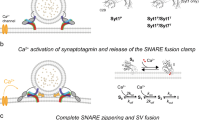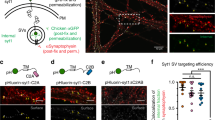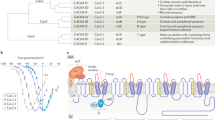Abstract
NEUROTRANSMITTER release is initiated by influx of Ca2+ through voltage-gated Ca2+ channels1,2, within 200 μs of the action potential arriving at the synaptic terminal3, as the Ca2+ concentration increases from 100 nM to >200μM4. Exocytosis requires high Ca2+ concentration, with a threshold of 20–50 μM and half-maximal activation at 190 μM5,6. The synaptic membrane proteins syntaxin7,8, 25K synaptosome-associated protein (SNAP25)9, and vesicle-associated membrane protein (VAMP)/ synaptobrevin10–12, are thought to form a synaptic core complex which mediates vesicle docking and membrane fusion13–19. Synaptotagmin may be the low-affinity Ca2+-sensor20–24, but other Ca2+-sensors are involved25–27 as residual neurotransmission persists in synaptotagmin-null mutants. Syntaxin binds to N-type Ca2+ channels7,8,28,29 at a site in the intracellular loop connecting domains II and III30. Here we describe Ca2+-dependent interaction of this site with syntaxin and SNAP25 which has a biphasic dependence on Ca2+, with maximal binding at 20 μM free Ca2+, near the threshold for transmitter release. Ca2+-dependent interaction of Ca2+ channels with the synaptic core complex may be important for Ca2+-dependent docking and fusion of synaptic vesicles.
This is a preview of subscription content, access via your institution
Access options
Subscribe to this journal
Receive 51 print issues and online access
$199.00 per year
only $3.90 per issue
Buy this article
- Purchase on Springer Link
- Instant access to full article PDF
Prices may be subject to local taxes which are calculated during checkout
Similar content being viewed by others
References
Smith, S. J. & Augustine, G. J. Trends Neurosci. 11, 458–464 (1988).
Robitaille, R., Adler, E. M. & Charlton, M. P. Neuron 5, 773–779 (1990).
Barrett, E. F. & Stevens, C. F. J. Physiol., Lond. 227, 691–708 (1972).
Llinás, R., Sugimori, M. & Silver, R. B. Science 256, 677–679 (1992).
Heidelberger, R., Heinemann, C., Neher, E. & Matthews, G. Nature 371, 513–515 (1994).
von Gersdorff, H. & Matthews, G. Nature 367, 735–739 (1994).
Bennett, M. K., Calakos, N. & Scheller, R. H. Science 257, 255–259 (1992).
Yoshida, A. et al. J. biol. Chem. 267, 24925–24928 (1992).
Oyler, G. A. et al. J. Cell Biol. 109, 3039–3052 (1989).
Trimble, D. M., Cowan, D. M. & Scheller, R. H. Proc. natn. Acad. Sci. U.S.A. 85, 4538–4542 (1988).
Elferink, L. A., Trimble, W. S. & Scheller, R. H. J. biol. Chem. 264, 11061–11064 (1989).
Südhof, T. C. & Jahn, R. Neuron 6, 665–677 (1991).
Söllner, T. et al. Nature 363, 318–324 (1993).
Söllner, T., Bennett, M. K., Whiteheart, S. W., Scheller, R. H. & Rothman, J. E. Cell 75, 409–418 (1993).
Söllner, T. & Rothman, J. E. Trends Neurosci. 17, 344–348 (1994).
Pevsner, J. et al. Neuron 13, 353–361 (1994).
Calakos, N., Bennett, M. K., Peterson, K. & Scheller, R. H. Science 263, 1146–1149 (1994).
Hayashi, T. et al. EMBO J. 13, 5051–5061 (1994).
DeBello, W. M. et al. Nature 373, 626–630 (1995).
Perin, M. S. Fried, V. A., Mignery, G. A., Jahn, R. & Südhof, T. C. Nature 345, 260–263 (1990).
Brose, N., Petrenko, A. G., Südhof, T. C. & Jahn, R. Science 256, 1021–1025 (1992).
Davletov, B. A. & Südhof, T. C. J. biol. Chem. 268, 26386–26390 (1993).
Chapman, E. R. & Jahn, R. J. biol. Chem. 269, 5735–5741 (1994).
Geppert, M. et al. Cell 79, 717–727 (1994).
DiAntonio, A. K., Parfitt, D. & Schwarz, T. L. Cell 72, 1281–1290 (1993).
Nonet, M., Grundahl, K., Meyer, B. J. & Band, J. B. Cell 73 1291–1305 (1993).
Littleton, J. T., Stern, M., Schulze, K., Perin, M. & Beller, H. J. Cell 74, 1125–1134 (1993).
O'Conner, V. M., Shamotienko, O., Grishin, E. & Betz, H. FEBS Lett. 326, 255–261 (1993).
Lévêque, C. et al. J. biol. Chem. 269, 6309–6312 (1994).
Sheng, Z.-H., Rettig, J., Takahsahi, M. & Catterall, W. A. Neuron 13, 1301–1313 (1994).
Author information
Authors and Affiliations
Rights and permissions
About this article
Cite this article
Sheng, ZH., Rettig, J., Cook, T. et al. Calcium-dependent interaction of N-type calcium channels with the synaptic core complex. Nature 379, 451–454 (1996). https://doi.org/10.1038/379451a0
Received:
Accepted:
Issue Date:
DOI: https://doi.org/10.1038/379451a0
This article is cited by
-
Voltage-dependent CaV3.2 and CaV2.2 channels in nociceptive pathways
Pflügers Archiv - European Journal of Physiology (2022)
-
Human Pluripotent Stem Cell-Derived Neurons Are Functionally Mature In Vitro and Integrate into the Mouse Striatum Following Transplantation
Molecular Neurobiology (2020)
-
SNAP-25 isoforms differentially regulate synaptic transmission and long-term synaptic plasticity at central synapses
Scientific Reports (2019)
-
AAV-encoded CaV2.2 peptide aptamer CBD3A6K for primary sensory neuron-targeted treatment of established neuropathic pain
Gene Therapy (2019)
-
The Association of SNAP25 Gene Polymorphisms in Attention Deficit/Hyperactivity Disorder: a Systematic Review and Meta-Analysis
Molecular Neurobiology (2017)
Comments
By submitting a comment you agree to abide by our Terms and Community Guidelines. If you find something abusive or that does not comply with our terms or guidelines please flag it as inappropriate.



